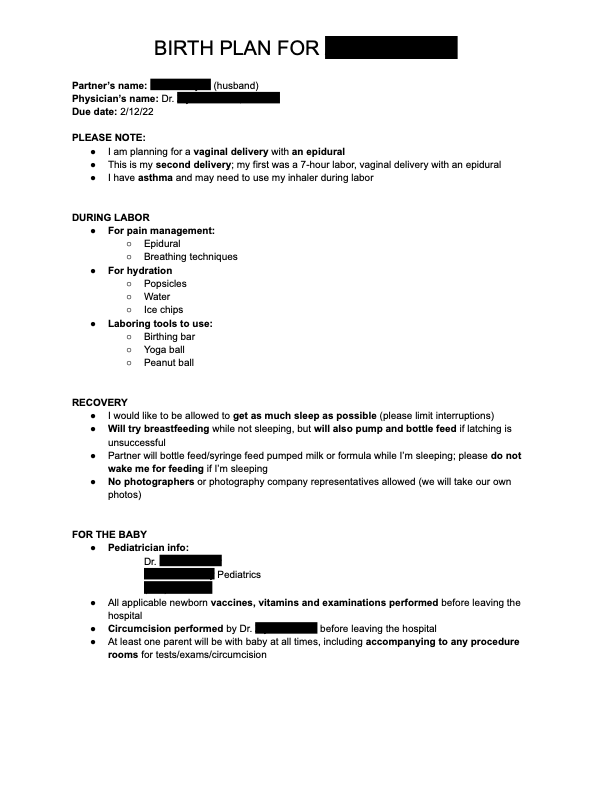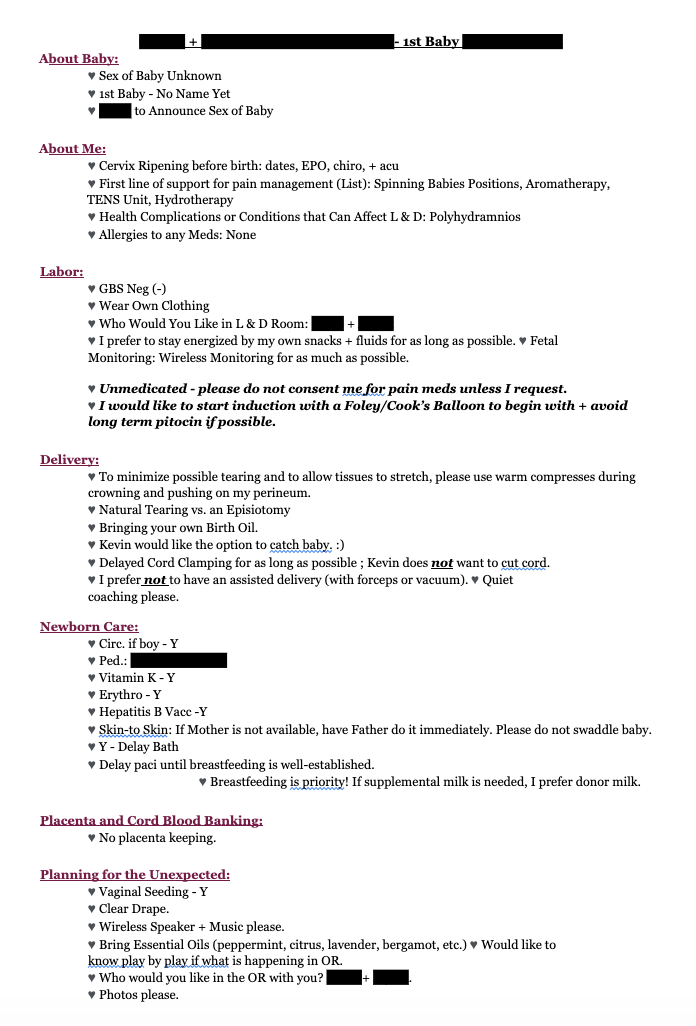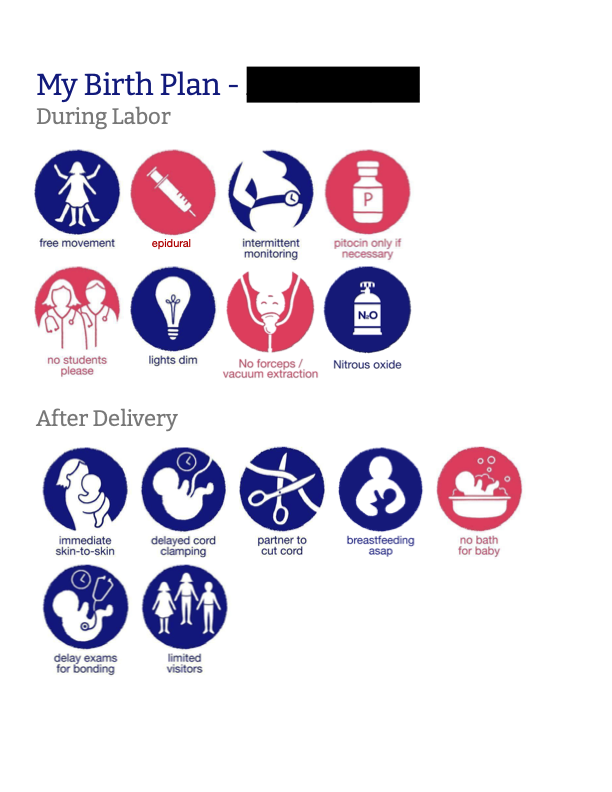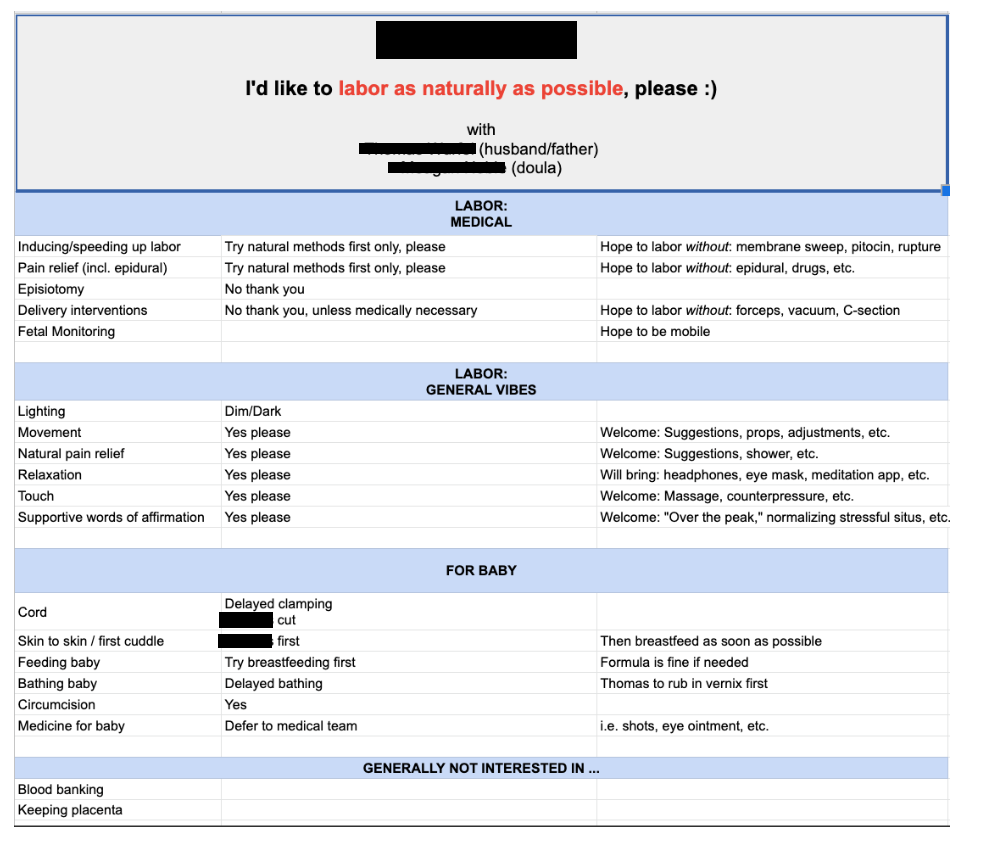
Babylist editors love baby gear and independently curate their favorite products to share with you. If you buy something through links on our site, Babylist may earn a commission.


The ideal scenario for any birth is that things go smoothly and everyone is healthy. But there are a lot of different ways to give birth, and your version of things “going smoothly” could be different from someone else’s.
A birth plan defines your version of an ideal birth scenario and communicates it to your care team, ensuring everything goes as smoothly as possible. But what does a birth plan look like? Read on for a step-by-step guide to creating yours as well as real-life birth plan examples and a downloadable template.
A birth plan is a document that lets your medical team know your labor and delivery preferences in regards to things like pain management, postpartum care, newborn procedures and even the vibes of the delivery room (lights, aromatherapy, etc.).
Think of your birth plan as a guideline or even a map. You have your destination (healthy baby and healthy you) and your preferred path for getting there, and your healthcare team will stick to that path as much as they possibly can. But keep in mind that there might be detours along the route—sometimes things don’t go as planned.
While it can be scary to think about something unexpected happening while giving birth, it doesn’t necessarily mean your birth plan goes entirely out the window. Your care team still has your and your baby’s health, safety and comfort top-of-mind while tending to an unexpected event, and including a space on your birth plan for things like emergency C-section (there are options for that!) and other delivery interventions will help guide them.
Almost anything you want can go on your birth plan. But we emphasize almost, because the available options may vary by location. So before you start writing out your preferences, research your options ahead of time:
Once you’ve researched the most important details, it’s time to customize your options! And try to keep it simple. Your birth plan doesn’t need to be exhaustive—make it short and easy to read at a glance. There’s typically a lot going on in the labor and delivery department, so your care team will appreciate not having to read through multiple pages of your birth plan. Keep it to one page and use bullet points or highlighting where you can.
This doesn’t mean write an About Me report, but you will want to list important medical info. It might happen that you arrive at tbe L&D ward and there’s a doctor on call whom you’ve never met. This is also true for your labor and delivery nurses.
While medical conditions should be on your patient chart, it’s a good idea to list them in the same place as your birth preferences as well. Include things like:
The labor question that gets all the attention: are you planning a medicated or unmedicated delivery? This Pain Medications Preference Scale by physical therapist Penny Simkin is really helpful if you need assistance articulating how you feel about pain management in labor.
Medication: The typical medication options for labor are an epidural, a spinal block, opiods via IV, local anesthetic and nitrous oxide.
Non-medicated options: Non-medicated (also called non-pharmacological) pain relief options include breathing techniques, hot and/or cold compresses, massage and counterpressure, aromatherapy, hyrotherapy (bath or shower), meditation and movement as well as “labor tools” like a birthing ball, peanut ball or squat bar.
To some extent, even in the hospital, you can make decisions on what your birthing environment looks like. Let your healthcare team know your preferences on:
Besides your preferred method of delivery (vaginal, assisted vaginal, C-section or VBAC), add some preferences about positions for pushing, if you have them. Some options are lying on your back, lying on your side, squatting, standing or leaning, kneeling/on all fours or being in a birthing tub.
Other delivery options that might go on a birth plan are a mirror to see the birth as it happens, who will be cutting the cord and preferences for skin to skin after the birth.
No one wants to think of what could happen during labor and delivery, but it’s important to plan for the unexpected, or at least to list your preferences.
If you’re planning for an unassisted vaginal birth, there’s a chance your doctor might tell you that some assistance tools will help things go more smoothly. If case this happens, write on your birth plan how you feel about the use of forceps, vacuum or an episiotomy.
If you’re planning for a vaginal birth but end up needing an emergency C-section, there are still some options you can request for your own comfort, including:
Hospitals and birthing centers have several procedures just for newborns, and they’re also important to include on your birth plan. Write down your desires for:
Other information to include are baby’s pediatrician information, including their name, clinic and phone number, whether you will be banking the cord blood and whether you will be keeping the placenta.
Once your birth plan is finished and printed, highlight your main preferences on it for fast reference. That way if a care provider only has time to glance at it, they’ll easily be able to spot the most important parts of your birth plan.
Bring your birth plan to one of your doctor appointments and discuss it with them so they understand what you’re hoping for during your birth. And make sure to include it on your hospital bag checklist so you’ll have it with you on the big day.
Every birth plan will look different, and not just the preferences. Birth plans come in all types of formats. Here are some examples (from real people!) of what birth plans can look like, from basic word processor documents to visual-based templates to spreadsheets.
EXAMPLE 1

EXAMPLE 2

EXAMPLE 3

EXAMPLE 4

Ready to write up your birth plan? Here’s a template (specially made for you by Babylist!) that you can download, print and fill out.
Looking for the best items for your growing family? Add all your favorite baby products to ONE registry with Babylist.

Amylia Ryan is the Associate Editor at Babylist, specializing in the topics of health, wellness and lifestyle products. Combining a decade of experience in writing and editing with a deep passion for helping people, her number one goal in her work is to ensure new parents feel supported and understood. She herself is a parent to two young children, who are more than willing to help product test endless toys, books, clothes, toiletries and more.
This information is provided for educational and entertainment purposes only. We do not accept any responsibility for any liability, loss or risk, personal or otherwise, incurred as a consequence, directly or indirectly, from any information or advice contained here. Babylist may earn compensation from affiliate links in this content. Learn more about how we write Babylist content and review products, as well as the Babylist Health Advisory Board.